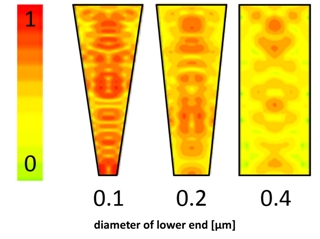Feb 26 2015
A biological structure in mammalian eyes has inspired a team headed by Silke Christiansen to design an inorganic counterpart for use in solar cells. With the help of conventional semiconductor processes, they etched micron-sized vertical funnels shoulder-to-shoulder in a silicon substrate.
 The simulation shows how the concentration of light (red = high concentration, yellow= low concentration) rises in the funnels with declining diameter of the lower end of the funnel. (Credit: G. Shalev, S. Schmitt/MPL)
The simulation shows how the concentration of light (red = high concentration, yellow= low concentration) rises in the funnels with declining diameter of the lower end of the funnel. (Credit: G. Shalev, S. Schmitt/MPL)
Using mathematical models and experiments, they tested how these kind of funnel arrays collect incident light and conduct it to the active layer of a silicon solar cell. Their result: this arrangement of funnels increases photo absorption by about 65% in a thin-film solar cell fitted with such an array and is reflected in considerably increased solar cell efficiency, among other improved parameters.
The fovea centralis, or fovea for short, sits in the middle of the Macula lutea (or macula) of the retina, where the slender, funnel-like ocular cones are especially closely packed together. We see an image with greatest acuity in this small region because each cone there is connected to a nerve cell.
This closely packed arrangement of cones has now inspired the team headed by Prof. Silke Christiansen to replicate something similar in silicon as a surface for solar cells and investigate its suitability for collecting and conducting light. Christiansen heads the Institute for Nanoarchitectures for Energy Conversion at the Helmholtz-Zentrum Berlin (HZB) and a research team at the Max Planck Institute for the Science of Light (MPL).
“We’ve shown in this work that the light funnels absorbs considerably more light than other optical architectures tested over the last while”, says Sebastian Schmitt, one of the two first authors of the publication that has appeared in the renowned journal Nature Scientific Reports.
Small change – large effect!
The researchers were surprised at just how large the effect of this architecture was, however. It was known from previous studies that arrangements of very thin vertical cylinders (a “carpet” of silicon nanowires) absorbs light well. But even tiny deviations in the shape of the cylinders right down to the shape of a funnel increased absorption. In comparison to the carpet of nanowires that has been investigated for some time, the funnel fields clearly perform better.
Yet manufacturing the light funnels requires no special effort and is feasible with conventional semiconductor processes such as reactive ion etching or wet chemical etching, for example. Compared with a silicon film of the same thickness, a layer of the light funnels increases the absorption of sunlight about 65%.
“Our modelling enabled us to also provide an explanation of why the arrays of light funnels trap light considerably better than a carpet of nanowires (as shown in our calculations in this publication) Optical modes in nanowires mutually interfere with each other. A field of closely arrayed nanowires therefore takes in light less efficiently than an identical number of single nanowires could. Just the opposite occurs with the light funnels: immediately neighbouring light funnels mutually strengthen one another’s absorption”, explains Schmitt
A look into the future
“Following this interesting initial result, we are pressing ahead in various directions”, says Christiansen. She and her team are working further on improving thin-film solar cells based on silicon and want to build the funnels into robust cell designs that can be economically realised over large surfaces. They will be able to access expertise at the Competence Centre Thin-Film- and Nanotechnology for Photovoltaics Berlin (PVcomB) of HZB where the division headed by Prof. Rutger Schlatmann has specialised in scaling up patterns developed in the lab and can rapidly and efficiently implement feasibility studies for large-area solar cells. “We hope you will hear from our collaboration again soon about a 30 cm x 30 cm funnel solar cell. Sebastian Schmitt is also working on using the funnels for other photonic applications in LEDs and sensor components, though. The first pilot studies are so promising that we are confident these applications will not have to remain the stuff of dreams”, Christiansen offers.